Easy kimchi recipe — just saying the words brings a tingle to my taste buds. It’s not just a dish for me; it’s a connection to the people, places, and plates that have shaped my culinary soul. My passion for food began in my family’s kitchen, where I was constantly surrounded by sizzling pans, vibrant spices, and the comforting aroma of meals made with care. Those early days taught me that food is more than nourishment — it’s love made visible.
As I grew older, my journey through cooking took me across cultures and cuisines. I trained professionally, studied food traditions, and spent countless hours experimenting in kitchens — big and small. But no matter how far I ventured from home, I always circled back to the dishes that bring people together at the table. That’s why this recipe for simple kimchi holds such special meaning. It was one of the first Korean recipes I attempted with the encouragement of my Korean mother-in-law. While she’s a master of over a hundred kimchi varieties, she lovingly taught me that mak kimchi — simple, everyday kimchi — is the perfect place to begin.
In this guide, I’ll walk you through every step of making this classic fermented dish in your own kitchen. You don’t need to be a fermentation expert or own special equipment — just a willingness to learn and a little patience. You’ll get the key steps, tips to avoid common mistakes, and even serving suggestions to bring the best out of every batch.
Table of Contents
What Is Kimchi and Why Make It at Home?
The Cultural Roots of Kimchi
Kimchi is more than a dish — it’s a cornerstone of Korean cuisine and culture, steeped in tradition and shared across generations. At its heart, kimchi is fermented vegetables, most commonly napa cabbage, seasoned with a blend of garlic, ginger, red pepper flakes, and other flavor-packed ingredients. But to millions, it represents family, home, and identity.
In Korean households, making kimchi is often a community ritual called kimjang, where families and neighbors gather to prepare large batches to last through the winter. It’s an act of love, patience, and preservation — a celebration of food that brings people together and nourishes more than the body.
This easy kimchi recipe may be scaled down and simplified, but it still captures the soul of the process: transforming humble ingredients into something rich, tangy, and alive with flavor.
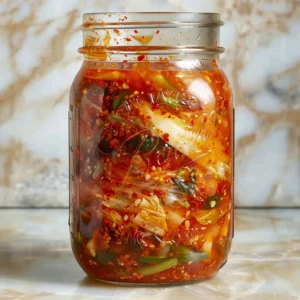
Easy Homemade Kimchi
Ingredients
- 1 medium napa cabbage
- 1/4 cup sea salt
- 1 tbsp garlic
- 1 tsp ginger
- 1 tsp sugar
- 2 tbsp fish sauce or alt.
- 1 –5 tbsp gochugaru
- 8 oz daikon radish
- 4 scallions
Instructions
- Cut the cabbage. Cut the cabbage lengthwise through the stem into quarters. Cut the cores from each piece. Cut each quarter crosswise into 2-inch-wide strips.
- Salt the cabbage. Place the cabbage in a large bowl and sprinkle with the salt. Using your hands, massage the salt into the cabbage until it starts to soften a bit. Add enough water to cover the cabbage. Put a plate on top of the cabbage and weigh it down with something heavy, like a jar or can of beans. Let stand for 1 to 2 hours.
- Rinse and drain the cabbage. Rinse the cabbage under cold water 3 times. Set aside to drain in a colander for 15 to 20 minutes. Meanwhile, make the spice paste.
- Make the spice paste. Rinse and dry the bowl you used for salting. Add the garlic, ginger, sugar, and fish sauce, shrimp paste, or water and stir into a smooth paste. Stir in the gochugaru, using 1 tablespoon for mild and up to 5 tablespoons for spicy (I like about 3 1/2 tablespoons); set aside until the cabbage is ready.
- Combine the vegetables and spice paste. Gently squeeze any remaining water from the cabbage and add it to the spice paste. Add the radish and scallions.
- Mix thoroughly. Using your hands, gently work the paste into the vegetables until they are thoroughly coated. The gloves are optional here but highly recommended to protect your hands from stings, stains, and smells!
- Pack the kimchi into the jar. Pack the kimchi into a 1-quart jar. Press down on the kimchi until the brine (the liquid that comes out) rises to cover the vegetables, leaving at least 1 inch of space at the top. Seal the jar.
- Let it ferment for 1 to 5 days. Place a bowl or plate under the jar to help catch any overflow. Let the jar stand at cool room temperature, out of direct sunlight, for 1 to 5 days. You may see bubbles inside the jar and brine may seep out of the lid.
- Check it daily and refrigerate when ready. Check the kimchi once a day, opening the jar and pressing down on the vegetables with a clean finger or spoon to keep them submerged under the brine. (This also releases gases produced during fermentation.) Taste a little at this point, too! When the kimchi tastes ripe enough for your liking, transfer the jar to the refrigerator. You may eat it right away, but it’s best after another week or two.
Notes
Equipment
- Cutting board and knife
- Large bowl
- Gloves (optional but highly recommended)
- Plate and something to weigh the kimchi down, like a jar or can of beans
- Colander
- Clean 1-quart jar with canning lid or plastic lid
- Bowl or plate to place under jar during fermentation
The Benefits of Homemade Kimchi
So why should you make kimchi at home when you can buy it from any grocery store or Korean market?
Because homemade kimchi is:
- Fresher and customizable – Adjust the spice level, tweak the garlic and ginger, and skip the seafood if you’re vegetarian.
- Healthier – You control the ingredients, avoiding preservatives or added sugars found in some store-bought versions.
- Rich in probiotics – Lacto-fermentation creates natural probiotics that boost gut health and digestion.
- Satisfyingly hands-on – The process of salting, seasoning, and fermenting your own kimchi is grounding and deeply rewarding.
Once you’ve tasted your own batch of homemade kimchi, bright with garlic and heat, crisp with radish and cabbage, and bubbling with life — there’s no going back.
The Science Behind the Easy Kimchi Recipe
How Fermentation Works with Napa Cabbage
The magic of any easy kimchi recipe lies in one ancient and beautiful process: lacto-fermentation. This method doesn’t just preserve the cabbage — it transforms it.
Here’s what happens:
- Stage One: Salting the Cabbage
To start, napa cabbage is submerged in a brine made of saltwater.This stage is crucial because it draws out excess moisture, softens the leaves, and most importantly, creates an environment that discourages harmful bacteria. - Stage Two: Fermentation Begins
After salting, the cabbage is mixed with a spicy, garlicky paste and sealed in a jar. That’s when Lactobacillus, the friendly bacteria, get to work. The natural sugars in the vegetables are consumed and converted into lactic acid by them, resulting in a natural preservative that imparts kimchi with its characteristic tang.
It’s the same process used to make yogurt, sauerkraut, and sourdough — but with bold Korean flavors that ignite the senses.
Lacto-Fermentation and Gut Health Benefits
Besides flavor, fermentation brings serious nutritional perks to the table. This is why your stomach will be grateful:
| Benefit | How It Helps |
|---|---|
| Rich in probiotics | Supports digestion and gut flora |
| High in vitamins (A, B, C, K) | Enhances immune function and cellular well-being |
| Natural anti-inflammatory agents | May reduce inflammation |
| Low in calories, high in fiber | Promotes satiety and healthy digestion |
Fermented foods like kimchi are now recognized not just for tradition, but for their functional health benefits. It’s like having your favorite spicy condiment and a probiotic supplement in one jar.
Essential Ingredients for a Basic Kimchi Recipe
Traditional vs. Vegetarian-Friendly Options
One of the best things about this easy kimchi recipe is its flexibility. While traditional recipes often use seafood-based ingredients like salted shrimp or anchovy sauce, you can absolutely make a flavorful vegetarian version without sacrificing depth.
Here’s a breakdown of traditional ingredients:
- Napa cabbage – The foundation. Crunchy, softening beautifully as it ferments.
- Essential for brining, non-iodized sea salt should be used to avoid the fermentation-inhibiting effects of iodized salt.
- Garlic & ginger – Provide sharp, aromatic bite.
- Korean red pepper flakes (gochugaru) – Gives the iconic color and spicy kick.
- Shrimp paste or fish sauce – Provides umami and a rich flavor.
- Sugar – Balances the salt and heat.
- Scallions & radish – For extra crunch and flavor dimension.
For a vegetarian version, try:
- Use kombu (kelp) powder, miso paste, or tamari as alternatives to fish sauce.
- Skipping shrimp paste entirely.
- Adding extra garlic, mushroom powder, or fermented tofu for umami.
Ingredient Substitutions for Every Pantry
Need to improvise? You don’t need specialty store access to make great kimchi. Here are some smart swaps:
| Traditional Ingredient | Pantry-Friendly Substitute |
|---|---|
| Gochugaru | Crushed red pepper + paprika |
| Korean radish | Daikon or regular white radish |
| Fish sauce | Soy sauce, tamari, or miso |
| Sugar | Honey, agave, or coconut sugar |
Remember, the goal is balance: salty + spicy + tangy + umami. Once you’ve mastered the flavor profile, you can tweak the ingredients to suit your kitchen, culture, or cravings.
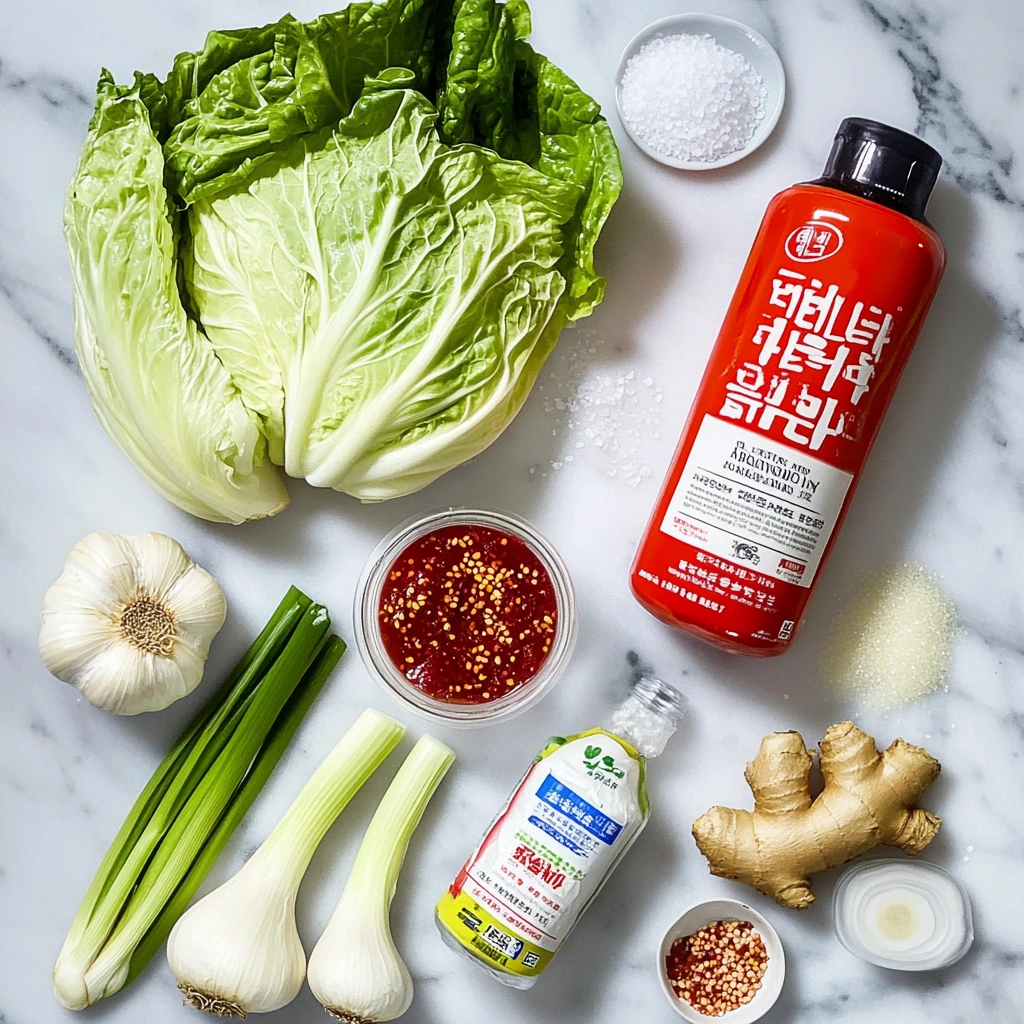
Kitchen Equipment You’ll Need to Make This Easy Kimchi Recipe
Must-Haves for First-Time Fermenters
One of the biggest myths about fermenting at home is that you need expensive tools. Not true. This easy kimchi recipe keeps things simple — you only need a few everyday kitchen essentials to get started.
If you’ve never fermented anything before, don’t worry. This fundamental kimchi recipe is an ideal introduction.. The tools listed below help streamline the process and ensure a successful, flavorful batch every time.
| Equipment | Why You Need It for Kimchi |
|---|---|
| Large mixing bowl | For salting cabbage and mixing everything evenly |
| Cutting board & knife | Essential for prepping napa cabbage, radish, scallions |
| Gloves (recommended) | Protect your hands from gochugaru and strong aromas |
| Colander | Efficiently wash and strain cabbage after salting |
| 1-quart glass jar | The fermentation vessel that houses your kimchi batch |
| Small plate + weight | Helps press down veggies to keep them submerged |
| Catch dish or plate | Catches overflow during the fermentation stage |
How to Prep Your Fermentation Station for an Easy Kimchi Recipe
Before you start fermenting your napa cabbage into delicious kimchi, it’s important to prep your space and tools. This helps ensure that your easy kimchi recipe ferments cleanly and safely.
1. Clean Everything Thoroughly
Sterilize your jar and wash all tools in hot, soapy water. A clean setup minimizes risk of bad bacteria and mold during fermentation.
2. Use Gloves When Mixing
Gochugaru, or Korean red pepper flakes, can stain your hands and nails. Gloves make the mixing process more comfortable and sanitary — especially when working that spicy paste into the veggies.
3. Leave Space for Fermentation Gases
When you pack your kimchi into the jar, leave about 1 inch of space at the top. This gives the natural gases room to expand and bubble up — a key part of this easy kimchi recipe’s fermentation success.
4. Find a Cool, Dark Storage Spot
Avoid windows or warm counters. Ferment your jar at room temperature (60–75°F) for 1 to 5 days in a shaded corner or pantry.
Step-by-Step Instructions for This Easy Kimchi Recipe
Making an easy kimchi recipe at home doesn’t require professional skills — just a bit of care, a clean setup, and a little fermentation magic. This beginner-friendly guide walks you through the process from prep to fermentation in nine simple steps.
Prepping and Salting the Cabbage
This is where every good easy kimchi recipe begins: prepping napa cabbage so it’s crisp, clean, and ready to transform.
Step 1: Cut the Cabbage
- Take one medium napa cabbage (about 2 lbs).
- Cut lengthwise into quarters, then crosswise into 2-inch strips.
- Discard the tough core.
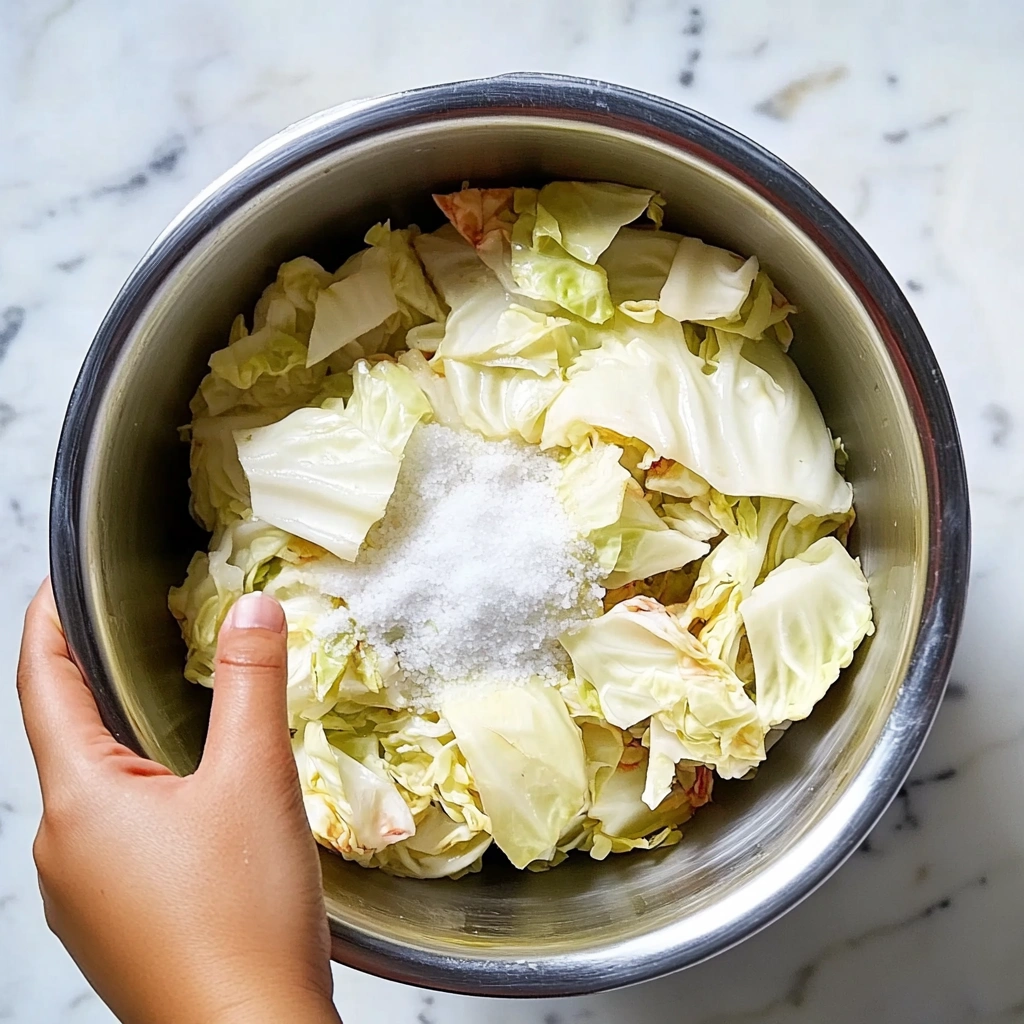
Step 2: Salt the Cabbage
- Add cabbage pieces to a large bowl.
- Sprinkle with 1/4 cup non-iodized sea salt.
- Rub the salt into the leaves for several minutes, then pour in water to fully cover the cabbage..
- Press it down with a plate and either a jar or can.
- Let it soak for 1–2 hours — a crucial step in any easy kimchi recipe.
Step 3: Rinse and Drain
- Wash the cabbage in cold water three times to eliminate any extra salt.
- Drain well in a colander for 15–20 minutes.
Mixing the Paste and Combining the Vegetables
Flavor is what sets this easy kimchi recipe apart — and it starts with the spice paste.
Step 4: Make the Spice Paste
- In a clean bowl, combine:
- 1 tbsp grated garlic
- 1 tsp grated ginger
- 1 tsp sugar
- 2 tbsp fish sauce or shrimp paste (or 3 tbsp water for a vegan batch)
- 1–5 tbsp gochugaru (Korean red pepper flakes). Start with 3 tbsp for medium spice.
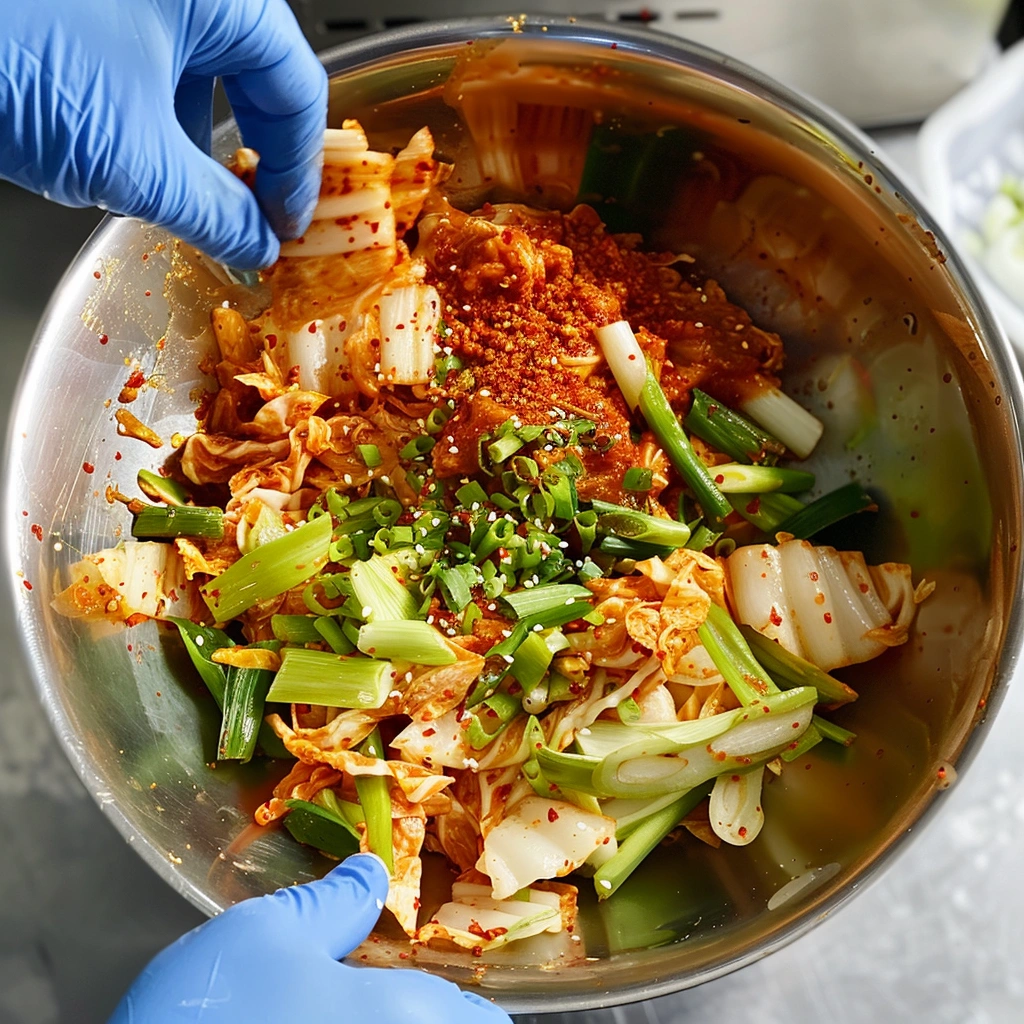
Step 5: Add Your Veggies
- Incorporate the drained cabbage, 8 ounces of julienned Korean or daikon radish, and 4 scallions (sliced into 1-inch segments) into the spice paste.
Step 6: Mix It All Together
- Wearing gloves, gently massage the mixture until everything is thoroughly coated.
- The veggies should appear glossy, juicy, and vibrantly red — just like a proper easy kimchi recipe should look.
Packing and Fermenting the Kimchi Properly
Step 7: Pack Your Jar
- Transfer the mixture into a clean 1-quart glass jar.
- Push it down with a spoon so that the brine comes up and covers the vegetables..
- Make sure to leave at least a 1-inch gap at the top..
Step 8: Let It Ferment
- Place the jar on a dish to catch overflow.
- Store at cool room temperature, away from direct sunlight, for 1 to 5 days.
- If this is your first time following an easy kimchi recipe, watch for bubbles — that’s your sign it’s working.
Step 9: Check It Daily
- Open the lid once a day to release gases and press down the veggies.
- Taste daily. When it reaches your desired tanginess, move it to the fridge.
- Kimchi can be eaten immediately but improves after a week or two.
Bonus Tip:
The longer it sits in the fridge, the deeper the flavor becomes. This is where a truly easy kimchi recipe proves its staying power — simple, adaptable, and absolutely delicious.
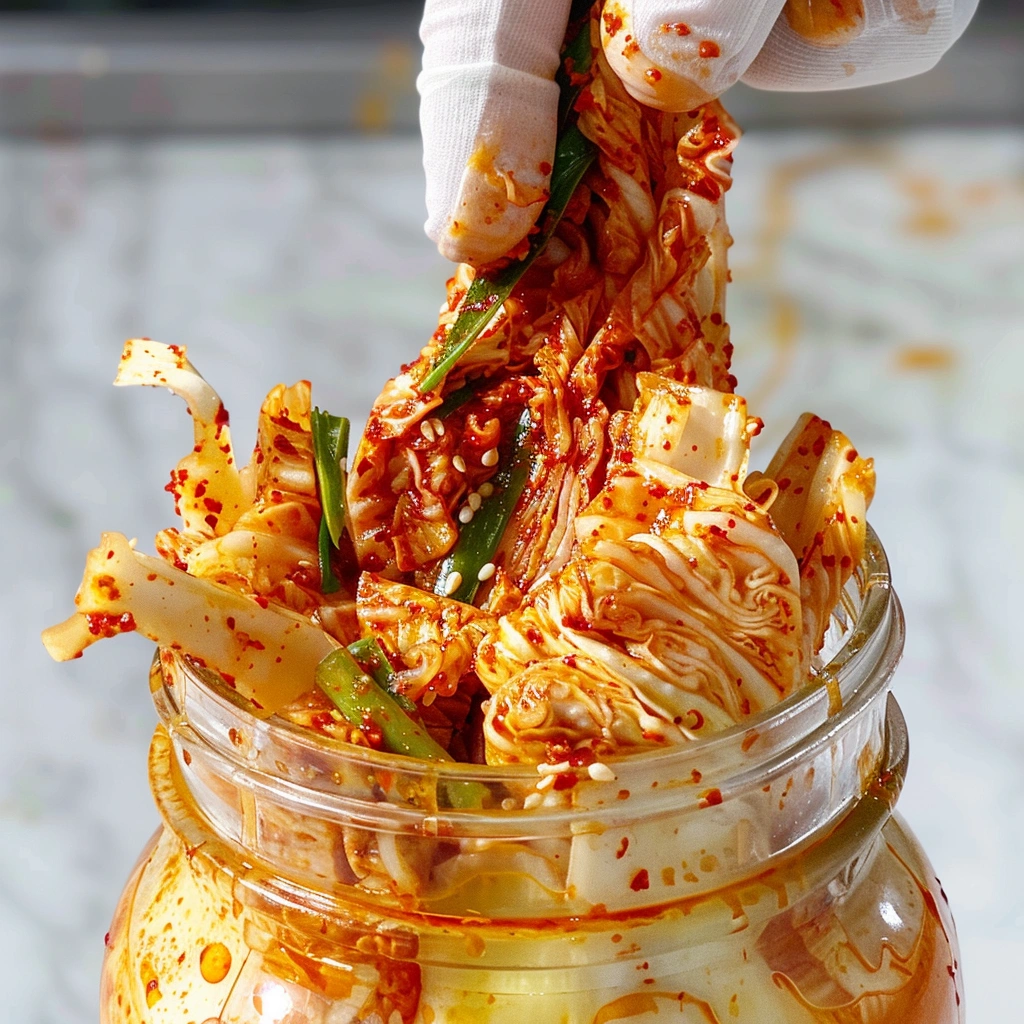
How to Know When Your Kimchi Is Ready
Key Signs Your Easy Kimchi Recipe Has Fermented Properly
So you’ve followed the steps, packed your jar, and waited a few days. Now comes the exciting part — figuring out if your easy kimchi recipe has hit that perfect stage of ripeness.
Here are the definitive signs that your kimchi is prepared for eating:
- Bubbles Inside the Jar
If you spot tiny bubbles rising or fizzing through the brine — congratulations, fermentation is active and healthy. - Brine Overflow or Lid Pressure
It’s normal for some liquid to seep out or the lid to feel pressurized. That’s due to the CO₂ being released during fermentation. - Tangy, Funky Aroma
Your kitchen might smell a little “funky” — but in a good way. A tangy, fermented scent means you’re on the right track. If it smells foul or rotten, discard it. - Sour, Zingy Taste
Take a small bite. If it tastes tangy, slightly sour, and still crunchy — your easy kimchi recipe is right on target. Want it stronger? Let it continue fermenting for another day or two..
Troubleshooting Common Kimchi Mistakes
Even the best home cooks hit bumps. Here’s how to troubleshoot common kimchi fermentation issues:
| Problem | What It Means | Fix |
|---|---|---|
| No bubbles after 2–3 days | Too cool, or not enough salt | Move to warmer spot (65–75°F) |
| Mold or white film on top | Possibly kahm yeast | Skim off, taste test. Discard if foul |
| Too sour after 1 day | Room was too warm | Refrigerate sooner next time |
| Too bland | Not enough spice or fermentation time | Let it sit longer; adjust paste next batch |
| Veggies aren’t submerged | Risk of spoilage | Press them down and reseal jar |
Fermentation is equal parts art and science. With practice, you’ll start to trust your senses. A good easy kimchi recipe will quickly become second nature.
How to Store and Serve Your Kimchi
Proper Storage Tips to Keep Your Easy Kimchi Recipe Fresh
Once your easy kimchi recipe has reached the perfect level of fermentation, it’s time to shift focus to storage. Good storage keeps your kimchi safe, flavorful, and ready to enjoy for weeks — or even months.
Short-Term Storage (Ready-to-Eat Kimchi)
- Refrigerate Immediately once your desired flavor is achieved.
- Store in an airtight glass jar with the lid tightly sealed.
- To prevent spoilage, keep vegetables completely submerged in brine..
- Use clean utensils each time to avoid introducing bacteria.
Kimchi continues to ferment in the fridge, but much more slowly. Over time, the flavor deepens — many people even prefer it after a few weeks.
Long-Term Storage
Want your kimchi to last up to 3 months or more?
- Transfer it to smaller jars to reduce exposure to air.
- Keep it in the back of your fridge, where it’s coldest and most stable.
- Add a layer of plastic wrap or wax paper under the lid to improve seal.
How to Serve Kimchi (Hot, Cold, or In Recipes)
This easy kimchi recipe isn’t just a condiment — it’s the centerpiece of flavor-packed meals. Whether you want a quick snack or an exciting twist on classic dishes, here’s how to use your homemade batch.
Serve It Cold
- As a side dish with rice, noodles, or grilled meats.
- Add to rice bowls, Korean BBQ platters, or sushi rolls.
- Incorporate it into lettuce wraps with tofu or bulgogi..
Serve It Hot
- Sauté with garlic and sesame oil for a quick kimchi stir-fry.
- Incorporate into fried rice for a zesty, spicy flavor..
- Drop into soups and stews for depth (like kimchi jjigae).
- Use as a pizza topping or in grilled cheese for fusion fun.
Nutritional Benefits and Dietary Adaptations
Why This Easy Kimchi Recipe Is a Gut-Healthy Superstar
One of the best parts about this easy kimchi recipe? It’s not just delicious — it’s incredibly good for you. Kimchi is loaded with health-supportive nutrients that make it a smart addition to your daily diet, especially when fermented naturally at home.
Key Nutritional Benefits of Homemade Kimchi:
- Probiotics
Thanks to the natural lacto-fermentation process, kimchi is rich in Lactobacillus, a beneficial bacteria that supports gut health, digestion, and even immune function. - Low in Calories, Big in Flavor
One serving of this easy kimchi recipe is packed with spice and tang, but barely 20 calories. It’s a great way to add flavor without loading up on fat or carbs. - Rich in Vitamins and Antioxidants
Kimchi contains vitamins A, B, and C. The gochugaru and garlic bring powerful antioxidant and anti-inflammatory benefits to the table. - Supports Heart and Metabolic Health
Some studies suggest regular kimchi consumption may help regulate cholesterol, blood pressure, and blood sugar levels.
Adaptations: Make This Easy Kimchi Recipe Fit Your Lifestyle
This recipe is naturally gluten-free, low-carb, and dairy-free — but with a few simple tweaks, you can easily make it suit almost any diet.
Vegetarian or Vegan Version
- Swap fish sauce or shrimp paste with:
- Soy sauce
- Tamari
- Miso paste
- Seaweed powder (like kelp) for umami
This version still gives you that bold flavor without any animal products.
Low-Sodium Option
- Use less salt during brining, but ferment for a longer period.
- Rinse the cabbage more thoroughly before mixing it with the paste.
Keto-Friendly Notes
- This easy kimchi recipe is naturally low in carbs and sugar.
- Stick with gochugaru, garlic, and ginger — avoid sugary sauces or sweetened pastes.
Nutrition Breakdown (Approximate per ¼ cup serving)
| Nutrient | Amount |
|---|---|
| Calories | 20–25 |
| Carbohydrates | 2–4g |
| Fat | <0.5g |
| Protein | <1g |
| Sodium | 300–500mg |
| Probiotics | High (live cultures) |
Conclusion and Final Thoughts on This Easy Kimchi Recipe
Making your own easy kimchi recipe at home is more than just following steps — it’s a deeply rewarding process that connects you to tradition, flavor, and health all at once. Whether you’re a seasoned home cook or trying fermentation for the first time, this recipe proves you don’t need fancy tools or rare ingredients to make something extraordinary.
From the crunch of napa cabbage to the tangy punch of gochugaru, every bite of your homemade kimchi carries the flavor of patience, care, and time-honored technique. Plus, once you’ve mastered this basic method, you can start customizing — spicier, milder, vegan, or even with added veggies. The journey never ends, and every jar is unique.
If you’ve made it this far, you’re ready to make your first (or next) batch of homemade kimchi with confidence. And who knows? It might just become your new kitchen tradition.
for more recipes follow facebook and pintrest
FAQs About Kimchi for Beginners
Whether you’re just discovering fermented foods or diving into your first jar of homemade kimchi, questions are part of the process. Let’s walk through the most commonly asked questions related to this easy kimchi recipe, based on real user queries.
How to make a simple kimchi at home?
Simple is the keyword here. This easy kimchi recipe breaks it down into just a few core steps:
Salt and soak chopped napa cabbage.
Rinse and drain thoroughly.
Mix a spice paste with garlic, ginger, gochugaru, and fish sauce (or a vegan substitute).
Add scallions and radish, then coat all ingredients evenly.
Pack into a jar and ferment at room temp for 1–5 days.
What is the main ingredient in kimchi?
The heart of almost every kimchi variation is napa cabbage. In this easy kimchi recipe, it’s the star ingredient, providing the crunch and structure that’s softened and transformed through fermentation.
Other essential ingredients include:
Korean red pepper flakes (gochugaru)
Garlic & ginger
Fish sauce or a salty, umami-rich substitute
Daikon radish & scallions
What are the mistakes with making kimchi?
Even the best intentions can run into fermentation fails. Here are the most common mistakes when following an easy kimchi recipe — and how to avoid them:
Mistake
Fix
Using iodized salt
Use sea salt or kosher salt — no iodine or anti-caking agents.
Skipping rinsing after salting cabbage
Rinse 2–3 times to avoid overly salty kimchi.
Not submerging the vegetables
Always press veggies below the brine level.
Sealing the jar too tight
Leave room for gas to escape or open daily during ferment.
Letting it ferment in sunlight
Keep it cool and dark — pantry or cupboard preferred.
How long does it take for kimchi to ferment?
Fermentation timing for this easy kimchi recipe depends on room temperature and your flavor preferences:
1–2 days: Light, crisp, and mildly tangy.
3–4 days: Balanced flavor with noticeable sourness.
5+ days: Deeper funk, richer color, and strong aroma.
You can refrigerate the kimchi at any point once it tastes good to you. It continues to mature slowly in the fridge and can last for weeks to months.


1 thought on “Easy Kimchi Recipe You Can Make at Home Today”
Comments are closed.